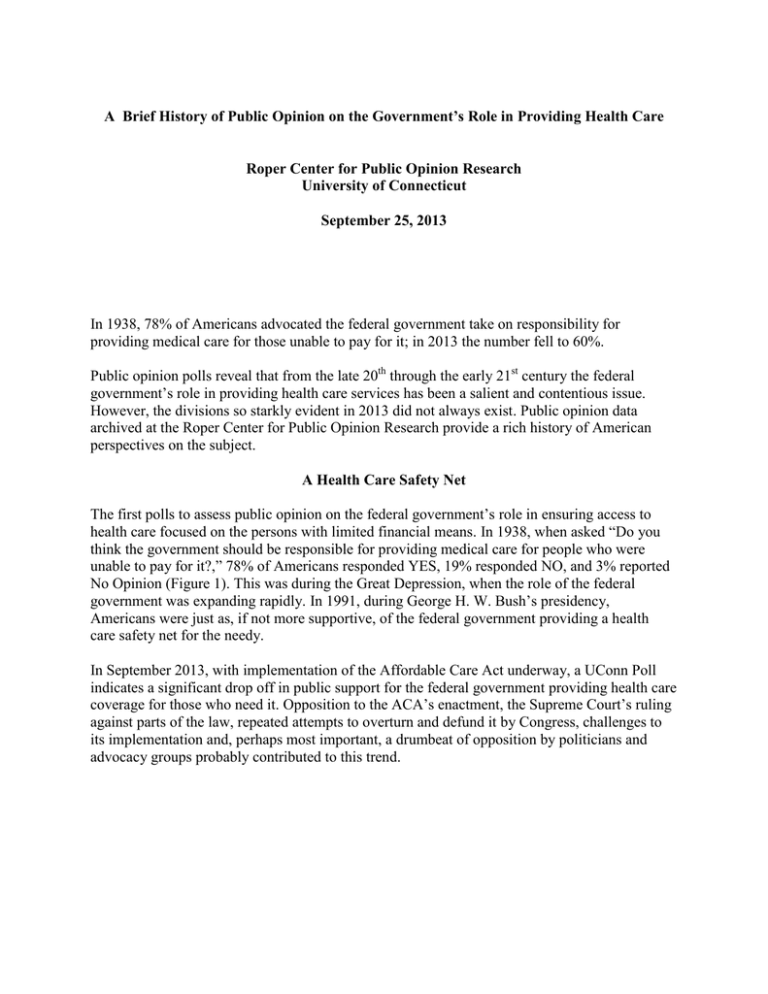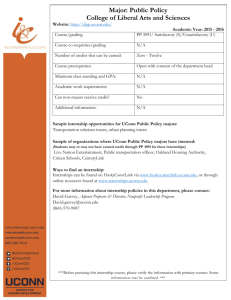A Brief History of Public Opinion on the Government’s... Roper Center for Public Opinion Research
advertisement

A Brief History of Public Opinion on the Government’s Role in Providing Health Care Roper Center for Public Opinion Research University of Connecticut September 25, 2013 In 1938, 78% of Americans advocated the federal government take on responsibility for providing medical care for those unable to pay for it; in 2013 the number fell to 60%. Public opinion polls reveal that from the late 20th through the early 21st century the federal government’s role in providing health care services has been a salient and contentious issue. However, the divisions so starkly evident in 2013 did not always exist. Public opinion data archived at the Roper Center for Public Opinion Research provide a rich history of American perspectives on the subject. A Health Care Safety Net The first polls to assess public opinion on the federal government’s role in ensuring access to health care focused on the persons with limited financial means. In 1938, when asked “Do you think the government should be responsible for providing medical care for people who were unable to pay for it?,” 78% of Americans responded YES, 19% responded NO, and 3% reported No Opinion (Figure 1). This was during the Great Depression, when the role of the federal government was expanding rapidly. In 1991, during George H. W. Bush’s presidency, Americans were just as, if not more supportive, of the federal government providing a health care safety net for the needy. In September 2013, with implementation of the Affordable Care Act underway, a UConn Poll indicates a significant drop off in public support for the federal government providing health care coverage for those who need it. Opposition to the ACA’s enactment, the Supreme Court’s ruling against parts of the law, repeated attempts to overturn and defund it by Congress, challenges to its implementation and, perhaps most important, a drumbeat of opposition by politicians and advocacy groups probably contributed to this trend. Figure 1. Public Opinion on Government Provision of a Health Care Safety Net 90% 80% 70% 60% 50% 40% 30% 20% 10% 0% 1938 1991 YES NO 2013 Don't know, No Opinion Question: Do you think the Government should be responsible for providing medical care for people who are unable to pay for it? Source: Gallup Organization, 1938-1991; UConn Poll, 2013. Note: The 1938 survey did not include a question on partisanship; this was measured by how respondents stated they intended to vote in the upcoming congressional election. Not surprisingly, Democrats historically have been the most supportive of providing health care to the needy (Figure 2). However, until recently substantial numbers of Republicans and Independents also favored this position. Between 1991 and 2013, support among Republicans and Independents fell by 31 and 20 percentage points, respectively. Figure 2. Public Support for Government Provision of a Health Care Safety Net, By Partisanship 100% 90% 80% 70% 60% 50% 40% 30% 20% 10% 0% 1938 Democrat 1991 Republican 2013 Independent Question and Source: See Figure 1. There was no category for Independents in the 1938 survey. In large part, the fluctuations in opposition can be attributed to the tenor of the times. The widespread poverty of the Great Depression and the programmatic responses of an activist federal government lent themselves to widespread support for another government program to support the poor. The skyrocketing costs of health care during the 1980s and 1990s apparently had similar effects. However, the polarized politics of 2013 undoubtedly contributed to the Republicans’ and others’ responsiveness to attacks on the Affordable Care Act, including those provisions of the ACA designed to help the less fortunate. Health Care as a Government Responsibility Moving beyond those of limited means, who should accept responsibility for helping to pay for doctors and hospital bills accrued by the broader public: the federal government, individuals, or some combination of the two? The devil is in the details. The responses Americans give seem to depend in large part on whether the specific details of a health care reform package are prominently featured on the political agenda. Polls conducted between 1975 and 2012 demonstrate that most Americans believe there is a role for government to play in providing health care. Figure 3 shows that during this period between 43% and 57% of all Americans agreed or strongly agreed with the view that the government has a responsibility to help pay medical bills, and between 27% and 39% indicated that both the government and individuals had a role in financing health care. Only between 14% and 21% of Americans held the opposite view—agreeing or strongly agreeing that people should take care of themselves. Figure 3. Public Support for Government vs. Individual Responsibility for Health Care 60% 40% 20% 0% Government responsibility Both Individual responsibility Don't know Question: In general, some people think that it is the responsibility of the government in Washington to see to it that people have help in paying for doctors and hospital bills. Others think that these matters are not the responsibility of the federal government and that people should take care of these things themselves. Where would you place yourself on this scale, or haven't you made up your mind on this? Responses for government responsibility constitute those who agree or strongly agree that health care is a government responsibility; responses for individual responsibility constitute those who agree or strongly agree people should take care of themselves; both indicates respondents who agree with both positions. Source: National Opinion Research Center, General Social Surveys. The figure demonstrates, support for the federal government’s role waxes and wanes in response to a variety of factors besides those mentioned in connection with health care programs for the poor. These include who occupies the White House and the state of the debate on health care reform. Public support was fairly high during the Nixon administration, fell somewhat, and then grew during the Reagan and George H.W. Bush administrations. During the late 1980s and 1990s, public support for a federal role in providing health care set the stage for the debate that took place during the 2000 presidential election. However, the well-publicized and highly partisan debate over health care reform resulted in support for reform declining, in part, as a result of the politicians and advocacy groups’ focus on details of the Clinton plan that proved unpopular. During George W. Bush’s presidency support for an enlarged government role in health care began to again increase. This laid the foundation for the Obama administration’s passage of the Affordable Care Act. As was the case during the Clinton years, a partisan drumbeat against some aspects of the program led to a decline in public support. The Supreme Court’s ruling, congressional opposition, and shortcomings in the ACA’s implementation, probably contributed to the decline in support for the federal government’s role. The September 2013 UConn Poll demonstrated that 44% of the public approved of the program and 46% disapproved (the remaining 10% held a neutral view). Democrats and Republicans have continuously disagreed about the proper role of the federal government in health care. Democratic support for government activity ranged from 55% to 68% between 1975 and 2012; Republican support ranged from a mere 21% to 50% during this period. The divergence among partisans was relatively modest for most of the 20th Century and widened when the ACA was first proposed and its provisions subjected to substantial scrutiny. Clearly, partisanship had a major impact on Americans’ views of the law and their overall opinions about the federal government’s role in providing health care more generally. Figure 4. Public Support for Government Responsibility for Health Care, by Partisanship 70% 60% 50% 40% 30% 20% 10% 0% Republicans Democrats Question and Source: See Figure 3. Contact: Paul Herrnson, Executive Director at the Roper Center Tel: 860-486-3828; email: paul.herrnson@uconn.edu The historical data used in this report and the contemporary data from the UConn Poll are part of the vast collection of public opinion data archived at the Roper Center for Public Opinion Research at the University of Connecticut. Within the archives, the opinions of the public on health care initiatives in the United States, as well as, a wide variety of other broad topics have been well-documented. To learn more, visit the website at www.RoperCenter.UConn.edu.




